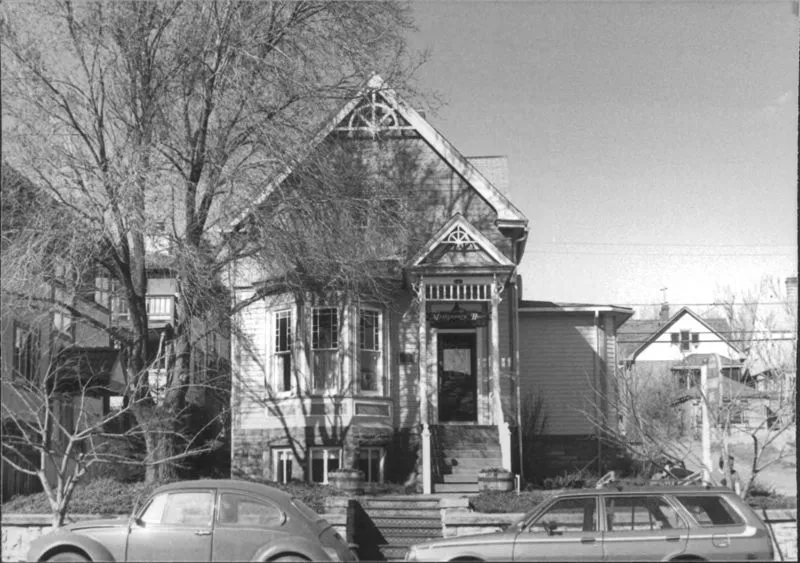Copyright Boulder Daily Camera

There’s something particularly spooky about late October in Boulder. Maybe it’s because by the time Halloween rolls around, the warm weather has evaporated, the sun sets at 6 p.m., the Flatirons have vanished into fog, westerly winds moan down the canyon and the whimsical smell of cow poop wafts over from Northern Colorado — a longtime Front Ranger’s adage that a cold front is on the way. Whatever may be going on outside, something about this time of year makes the city’s old buildings feel more alive. An eerie green light or a rattling window might make one pause just long enough to wonder who — or what — was here before you. But according to local experts, with most of Boulder’s supposed hauntings, the truth is more architectural than supernatural. The city’s “ghost stories,” it turns out, have less to do with restless spirits and more to do with history, preservation and a collective love of the mildly spooky. Last weekend, Historic Boulder hosted its sold-out “Ghost Walk Ghost Talk” tour, leading groups through five of the city’s oldest buildings, where psychics, historians and longtime residents explored stories of strange happenings, cold spots and the occasional locked door. “Halloween is one of the fastest-growing holidays in America, and people seem to just love to see spooky places,” said Leonard Segel, executive director of Historic Boulder, Inc. To lend the event some spectral credibility, Segel brought in local author, longtime Boulder resident and ghost researcher Ann Leggett, who has written several books on Boulder’s hauntings. Also on the tour were experts from the Lighthouse Bookstore and Psychic Horizons Boulder. “It’s a whole phenomenon that I’ll never discount,” Segel said. “I know enough in my life to believe there are things that exist in this world that I can’t explain. And Boulder is no different than any other town with homes that have visits from spirits.” Segel, an architect by training, added that much of what people experience as “haunted” can be chalked up to atmosphere and imagination. “Spaces have personalities and character,” he said. “Most people don’t walk into buildings older than 30 years, so to go into one that’s 100 years old is wholly different. The materials, the wood trim, the tile floor — people associate them with Hollywood’s portrayal of spooky places.” Still, Boulder has no shortage of buildings that fit that description. Among the most famous are the McInnes Mansion, 1020 Mapleton Ave. — known to locals as the “Wedding Cake Mansion” for its tiered white columns — where the sound of roller skates has reportedly echoed from the long-empty ballroom upstairs. “The psychics said they thought Mr. McInnes was there,” Segel said. “The current owners have said they’ve heard the sound of children roller skating on the top floor.” Then there’s the Grill Mansion, at 2305 Broadway, which has served as both a family home and a mortuary. “It’s had multiple lives,” Segel said. “Family home, mortuary, offices…it’s seen a lot of human history, and maybe that’s what people feel.” One of the most curious cases, though, might be at The New Local, at 741 Pearl St., Boulder. “The owners have said they’ve had doors locked on them from the inside,” Segel said. “They’ve left, gone outside, and somebody’s locked a door on the inside, when nobody’s even in the building.” Another one of the stops on this year’s Ghost Walk was the Carnegie Library for Local History, a stately 1906 sandstone building that once housed Boulder’s first public library. Archive manager Caroline Woodiel said it’s an ideal place to research Boulder’s ghost stories — and maybe even a good place to find one. “Any ghost story ever reported on in Boulder can be found in our wonderful little library,” Woodiel said. “If folks think their house may be haunted, our historical records can help them learn about who may have lived there before, how the physical house may have changed over time, and anything newsworthy that may have occurred at that location.” Carnegie’s old city directories and Daily Camera archives have helped visitors uncover everything from long-lost relatives to old mysteries. “We’ve even had people use our collections to help solve cases, like identifying a Jane Doe,” she said. Before the ghost walk, a group of local psychics from Lighthouse and Psychic Horizons was invited into the Carnegie to get a sense of the building’s energy. Several of them, Woodiel said, claimed they felt the presence of a librarian still lingering in the stacks — someone who had once worked there and was “still helping with research.” Woodiel said. “I have no idea if that’s true,” she said, “but if there is someone there doing that, I think it’s absolutely wonderful.” If a ghostly librarian were wandering the halls, it could very well be Clara Savory, Boulder’s first librarian, who served from 1895 to 1915. She helped shape the city’s early reading culture, and if anyone were still hanging around to keep the Dewey Decimal System in check, she could definitely be a contender. Woodiel said she never felt anything but welcome in the building. “Old buildings can sometimes feel creepy,” she said. “But I’ve never felt that way here. So if it is haunted, it must be by somebody wonderful.” And then, of course, there’s the Hotel Boulderado: The grande dame of Boulder hauntings, and the city’s most enduring ghost story. First opening its doors on New Year’s Day in 1909, the five-story brick landmark was Boulder’s first luxury hotel, complete with an Otis elevator, telephones in every room, and the stained-glass canopy that still crowns its lobby today. Over the years, its age, elegance, and creaky staircases have made it the centerpiece of local ghost tours and a favorite of amateur paranormal investigators. “I’ve worked here for 40 years,” said Laurel McKown, the hotel’s director of housekeeping and in-house historian. “There aren’t any ghosts walking the hallways or running up the staircase. People see something and interpret it different ways. A lot of that judgment is a bit jaded according to what they’re after, making a big deal out of something that perhaps isn’t.” Her office, she added, might be the most fitting place for a haunting — if one were to exist. It used to be the private room of Mr. Lawry, a permanent resident who lived and died in the hotel decades ago. “My office was Mr. Lawry’s old room, and I’ve been in it for a couple decades,” she said. “If there were ghosts in the hotel, this would be prime office space for some sort of sighting. I’m here all sorts of hours, and I’ve just never felt anything spooky in there. It’s a nice space.” McKown describes herself as “pretty sensitive to vibrations and feelings,” the sort of person who gets a read on a room the second she walks in. “I’ve never had any negative feelings or vibrations from this hotel,” she said. “It’s always been a source of very positive energy to me. Great history and energy. That’s always been my feeling, even before I worked here.” The 117-year-old hotel, with its grand staircase and glowing stained-glass ceiling, has seen its share of myths. McKown said what visitors call “hauntings” usually have simple explanations: old windows, old wiring and a few overzealous storytellers. She recalled one local ghost tour full of people who refused to give up a favorite tale about a “haunted” room. “They claimed guests saw an eerie green light under the door,” she said. “So I took them in. The windows face east, the curtains are green, and the morning sun just cast a green shadow. As soon as the sun moved, it was gone. But they were convinced even when they saw it.” The hotel’s reputation was also amplified by Banjo Billy’s Bus Tours, which, for years, rolled through town in a converted school bus offering “haunted Boulder” rides. “They picked a random room number and started telling people it was haunted,” McKown said. “Nothing had ever even happened in that room, but the story stuck.” To McKown, the Boulderado’s real magic isn’t in its ghosts, but in its endurance. “I don’t think ghost stories help the cause of preservation,” she said. “The attraction to ‘older’ buildings is because they’ve been around longer. But something restored and preserved, such as the Boulderado, is far from being an old spooky hotel.” Woodiel takes a gentler view, saying that she believes fascination with haunted places can draw people closer to history. “I think our curious nature as humans, and thinking about the people before us, whether through ghosts or through the architectural structures around our cities, ties us to the history that came before us,” she said. Segel sees it similarly. “These audiences who are interested in ghost stories and spooky houses might never walk in the door if you were just telling them about history or architecture,” he said. “There’s a hook, and it gets people to look at a building from a different perspective.” Maybe Boulder’s ghosts aren’t really ghosts at all, just creaky floors and good storytelling. But in a town this old, it’s comforting to think somebody’s still keeping watch, whether it’s a spectral librarian or our local in-house hotel historian.



